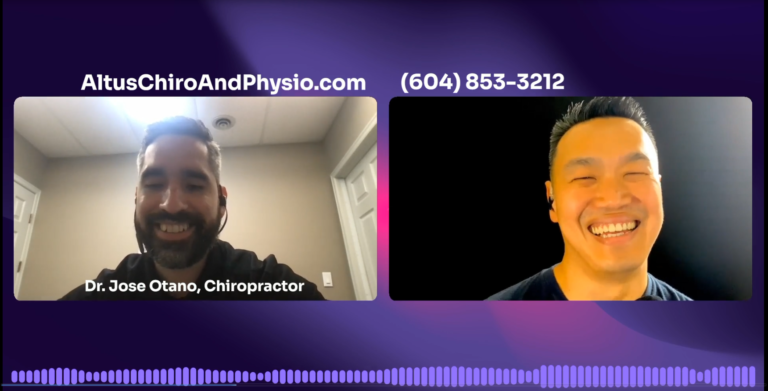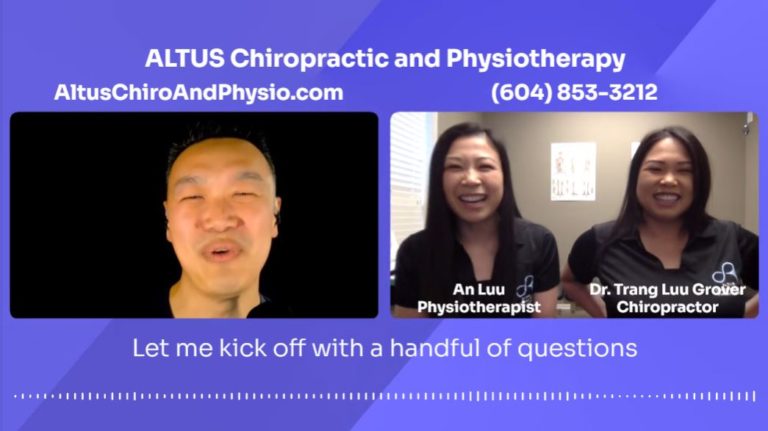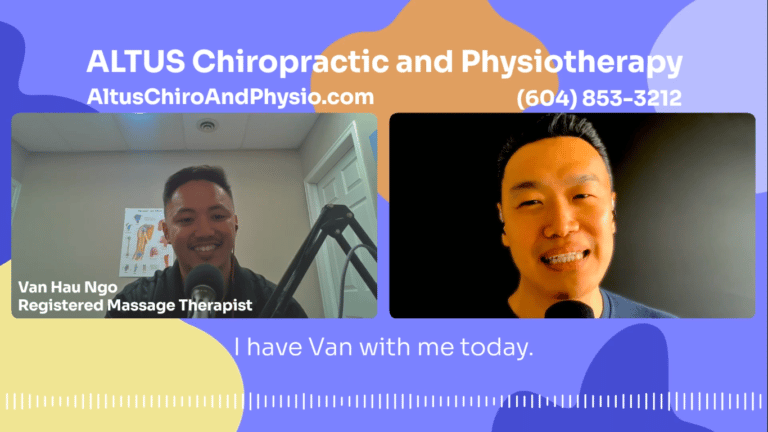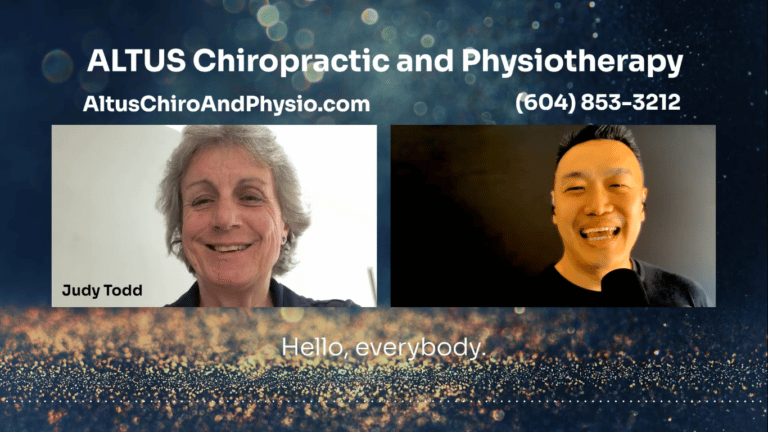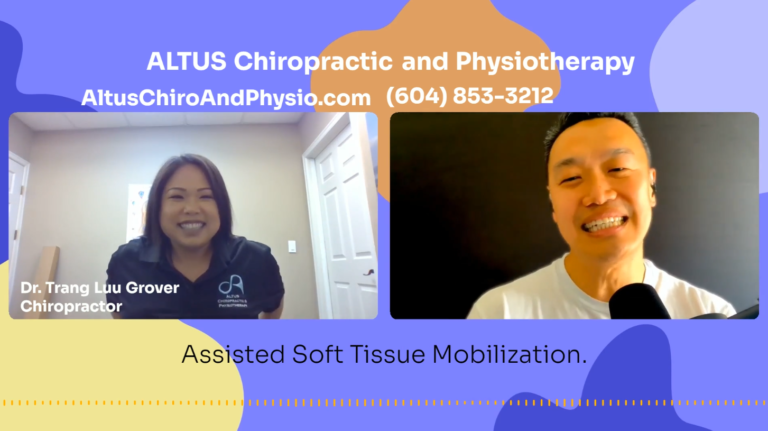Show Notes
[00:00:00] Sherman Hu: Welcome to another episode of the ALTUS Chiropractic and Physiotherapy podcast. I have Dr. Jose Otano here with me again. Jose, how you doing?
[00:00:09] Dr. Jose Otano: I’m doing great this afternoon. How are you doing?
[00:00:11] Sherman Hu: I’m very well and I’m very much looking forward to challenge myself to say this phrase, which is our topic today of TMJ is Temporomandibular Joint Disorder. Yay! I’m so proud of myself.
[00:00:25] Dr. Jose Otano: That’s it! It’s a big word. It’s a big word.
[00:00:27] Sherman Hu: Big word, big word.
[00:00:27] Dr. Jose Otano: That’s why we shortened it to those three letters, TMJ.
What is TMJ?
[00:00:30] Sherman Hu: That’s right. So what is it by the way? What is TMJ?
[00:00:33] Dr. Jose Otano: So I have actually a good skull here if you could see that. So this is actually your TMJ right there. See how it opens and closes, it’s actually the joint right there that opens and closes your mouth. Oops!
[00:00:47] Sherman Hu: And then it falls apart on you.
[00:00:49] Dr. Jose Otano: Then it falls apart. Yeah. So it’s just pretty much this area of the jaw that allows it to hinge and open and close. And it has like an articulation [00:01:00] between the skull itself and then the jaw.
[00:01:02] And then inside that jaw, you have a particular cartilage that kind of helps it move up and down. So it’s like a cushion. So it’s not like a bone-on-bone situation. And it just allows it to bite, open and close, deviate front and back, and side to side.
What is the main cause of TMJ?
[00:01:17] Sherman Hu: If there is a joint disorder, TMJ, what is the main cause of it?
[00:01:23] Dr. Jose Otano: So the main causes of it is, what I see the most is through muscles of the jaw, around the jaw, they get super tight from constant usage from chewing harder foods, chewing on one side of the mouth versus the other side because you’re favoring it due to pain on one side.
[00:01:40] So from my standpoint, I see it mostly for muscle issues. And then also, there’s trauma as well. So from whip lashes, head traumas can result in a jolt of the joint itself causing dysfunction of it from functionally moving accordingly. But then sometimes it’s caused by too much talking.
[00:01:58] As we see in actors and [00:02:00] actresses using their jaw muscles or singing too much, or just a strain in the musculature around the jaw in itself. Or clenching. Another one is actually clenching while you’re stressed and when you’re sleeping or clenching your jaw even more. So it actually causes the muscles around the jaw to even hurt even more. So stress is a big factor as well.
[00:02:21] Sherman Hu: Okay. Stress, chewing, and overuse of the muscles is what I’m hearing you say.
[00:02:27] Dr. Jose Otano: And then on rare occasions, trauma.
[00:02:29] Sherman Hu: And trauma too.
Who experiences a TMJ?
[00:02:30] Sherman Hu: So would you say there’s a percentage of the population that will experience this disorder? Does not everybody experience this?
[00:02:39] Dr. Jose Otano: Yeah. So there is a good amount of population. The statistics say around 40% of the population will experience a TMJ disorder in their life. But if it is something like where it’s stress-related, as soon as you remove the stress, it starts to calm down. Or as soon as you stop eating those chewy foods that are constantly causing those [00:03:00] muscles to tighten up, it will calm down. So people will experience it, but at most times it works itself out after a couple of days or a couple of hours.
[00:03:08] It depends on how long the pain arises or on how you got it. If it was from a trauma or a car accident, it can be serious. It can result in some headaches and some severe pain, but in most cases, if it is just over-usage or stress-related, it’s mild to moderate in seriousness of the disorder.
[00:03:31] Sherman Hu: Okay.
What does the pain of having a TMJ feel like?
[00:03:31] Sherman Hu: So for a viewer or listener, they may be hearing TMJ. They may not know anybody in their family or friend network that has it. What does that pain feel like if you could describe it?
[00:03:41] Dr. Jose Otano: Yeah. The intensity of the pain in the jaw can be from mild to severe.
[00:03:46] And it can be discomforting as well. It can be on one side of the job versus post sides as a jaw. And it can be tender to touch it. You’re constantly rubbing it affects your ability to open and close your mouth and chew [00:04:00] foods. You can hear crepitus, which is just like clicking in the jaw itself.
[00:04:05] Like it sticks, it affects your ability to talk sometimes, and then also it can cause some ear aches, neck pain, and some dizziness if it is moderate or severe. But in most cases, it’s just tenderness around the jaw itself and localized discomfort with earaches or headaches resulting from it as well.
[00:04:25] Sherman Hu: Okay, Jose, would you say then that it’s more of a numbing pain type of feeling versus acute pain?
[00:04:31] Dr. Jose Otano: It’s more of an acute pain because like it does happen fairly suddenly. And then as you’re like continuing on with it and if you’re ignoring it, it can turn into something longer lasting, but as soon as you can deal with it, relax the muscles around it, it will calm down.
Is TMJ a dental or medical issue?
[00:04:50] Sherman Hu: Would you say that TMJ is associated with a dental issue or is it a medical issue?
[00:04:57] Dr. Jose Otano: So that’s a great question. I would always say [00:05:00] that you want to start off with dental just to rule out any pathologies, or internal issues because TMJ is very close to the molars in the back of your teeth.
[00:05:11] So my suggestion is always to consult with your dentist to make sure that there isn’t a tooth issue, a gum issue, or any pathologies within the mouth, that they can examine right away. And then from there, they will set you up with anything that they can help you out with for any devices or any referrals or recommendations, what they can see fit.
[00:05:32] But then if it doesn’t get better and they say, no, your teeth are fine. Your gums are fine. Everything looks good. Then I would go see your medical doctor, your family physician, and then they will do an exam on the outside. And also looking at the musculature of the joint itself and medical doctors have their own specialists as well, as an ENT- eyes nose, and throat specialists that can do any further investigation as well on it.
[00:05:59] And they can [00:06:00] come up with the appropriate diagnosis of TMD, which is temporomandibular dysfunction slash disorder.
Can a TMJ be cured naturally?
[00:06:07] Sherman Hu: I heard you say earlier when stress is relieved, it may go away. So I guess my next question is, can it be cured or go away naturally on its own? It sounds like in certain situations it can. From your perspective, what have you seen?
[00:06:21] Dr. Jose Otano: I think it depends on what is causing the disorder or dysfunction. Unfortunately, if it’s arthritic, if it’s due to that like I said before that there was articular cartilage that prevents that jaw bone from hitting the skull bone. And if that articular cartilage is worn away, which we see with arthritis, there’s no way of coming out of it.
[00:06:43] You can do symptom management with it, but arthritis, you can’t really cure that. But if there is other issues of it, such as, it’s just strictly coming from clenching, from the muscles becoming super tight, then it can definitely be helped out. But then you’re [00:07:00] also looking at other conditions that are causing it such as the articular disc can be torn as well. So that results in more of a medical investigation, seeing the ENT or a TMJ dental specialist cure it as well. So it depends really on what is causing the TMJ disorder or dysfunction, because if it is the disc or the bones itself, then you’re helping with the symptoms, but if it’s just the muscles from overuse or tightening, then that can be cured.
[00:07:35] Sherman Hu: Okay. All right.
What do people with Ehlers-Danlos and MMA fighters do when experiencing a TMJ?
[00:07:36] Sherman Hu: Jose, I’m thinking two things, two different types of people. Folks who have Ehlers-Danlos, and folks who are boxers or MMA fighters. Do both of them get associated and affected for what they have or what they do?
[00:07:51] Dr. Jose Otano: Yeah. So with the Ehlers-Danlos, they have like elasticity of their connected tissues, so they’re very hypermobile. They can get [00:08:00] dislocations pretty easily, and you can also see that with MMA fighters and boxers that get constantly punched in the face. So they’re going to end up getting punched in the jaw because that’s the center point of knocking someone out is in that area.
[00:08:13] Those two conditions are very interesting because if you can get a fracture here, but then only the amount of times getting hit here, the muscles are going to start to get very locked and clenched and stuff in boxes and MMA fighters. They are both predisposed to having a lot of TMJ issues, but I would say they would have their own medical consult. With the Ehlers-Danlos, they already have people in the medical field looking after their care. And then the boxers and the MMA fighters have the athletic therapists that are really on point with them to make sure that they’re top-notch before a fight as well.
[00:08:49] Sherman Hu: Okay. Alright. That’s great.
The difference between a TMJ and a TMD?
[00:08:51] Sherman Hu: You mentioned earlier Jose about a TMD, so temporomandibular disorder, right? How has that the same or different from TMJ?
[00:08:59] Dr. Jose Otano: Yeah. [00:09:00] So I get that question a lot from patients. What’s the difference between a TMJ and a TMD? The TMD is the diagnosis of the TMJ. So if the TMJ, which is the joint itself, that’s what the J stands for, isn’t moving accordingly. It’s not functioning properly. We call it a TMD, which has a temporomandibular disorder or interchangeably temporomandibular dysfunction. So the function itself isn’t moving accordingly compared to normal values. So for example, the range of motion, there is pain with clicking or pain with articulation and stuff like that.
[00:09:36] So that’s the main difference. One is strictly talking about the joint, the TMJ, and one is talking about the diagnosis, TMD.
[00:09:43] Sherman Hu: Okay. It was not till today that I’ve heard of TMD. I’ve always known it to be TMJ.
What kind of treatment types are used for clients with TMJ or TMD?
[00:09:49] Sherman Hu: So as a practitioner, then what kind of modality or treatment types are you practicing or working with clients that have TMJ or TMD?
[00:09:57] Dr. Jose Otano: Yeah. So once we find the appropriate [00:10:00] diagnosis after they saw their dentist, sometimes it’s just after seeing the dentist, they get the diagnosis of a TMJ or TMD. They will, hopefully, I would always recommend getting them a night guard. A night guard is just like a retainer or like a mouth guard that they would wear at nighttime.
[00:10:15] It really helps in because it kinda sets the jaw in that neutral position. So they aren’t making things worse at nighttime when they’re sleeping. So that’s the number one thing I try to convince and help my patients get when they have a TMD disorder or a TMD.
[00:10:31] And then from there we do a lot of hands-on stuff. So it is a relaxation of the outer muscles, like your temporalities, your masseter on the outside. And then we do some internal relaxation or mobility on the inside, which is your pterygoids, which is on the back end of your jaw back here. So it has to put on a glove and do a little bit of muscle release on the inside of your jaw too.
[00:10:54] Sherman Hu: Wow. Okay.
[00:10:56] Dr. Jose Otano: And then after those muscles are nice and relaxed and [00:11:00] treated by massaging and stretching. We then can look at the range of motion on how they’re opening and closing. If we do need to do a little bit of mobility on the jaw itself, we do that as well. And then we offer them, give them exercises and stretches that they can do at home for at-home treatment.
[00:11:19] So that’s a lot of what the therapist would do, and it’s not only chiropractic. Massage therapy can do this. Physiotherapy can do this and chiropractors.
[00:11:28] Sherman Hu: Okay. That’s incredible. I didn’t know that much information about it, so I’m glad to be able to know more about it.
TMJ disorders will subside on their own, otherwise, seek professional help.
[00:11:34] Sherman Hu: Jose, in wrapping up today’s episode, any final words to our viewers watching this? They may have somebody they know that has TMJ. Somebody who is TMJ might be looking at this episode and going, “oh, I get it now”. Any final words that you have for them?
[00:11:48] Dr. Jose Otano: Yeah. Like I said, from the beginning, TMJ disorders can subside on their own. At most cases they do. So just don’t be alarmed about it give it a couple of days. If it’s still [00:12:00] bothersome and is still painful, or if you’re getting a clicking sensation with pain first, always start off with your dentist. Start there just to make sure that there are no other underlying issues. Go see your dentist. They’ll do an x-ray. They’ll do a follow-up. They will recommend and give you the proper diagnosis that it is a TMJ disorder that is causing your pain.
[00:12:21] Then from there, you can consult with any therapist that the patient feels comfortable with because a TMD disorder can be handled by a massage therapist, a physiotherapist, or even a chiropractor, so they don’t need to see that one therapist to help that TMD disorder, it can be any of those therapists that I just mentioned. They’re more than capable of helping you out with this disorder and it’s whatever the patient feels comfortable with.
[00:12:50] Sherman Hu: That’s great. Thank you, Dr. Otano here and there you have it! Temporomandibular joint dysfunction or disorder [00:13:00] is all you ever wanted to know about it.
[00:13:03] Dr. Jose Otano: You got it perfect on that.
[00:13:04] Sherman Hu: That’s awesome. Thank you for sharing so much information, and that brings us to the end of today’s ALTUS Chiropractic and Physiotherapy podcast.
[00:13:12] Stay tuned with us next week. As we cover more physiotherapy and chiropractic topics. Dr. Jose Otano, thank you so much and I look forward to having you on another episode soon.
[00:13:23] Dr. Jose Otano: Thank you, Sherman!

